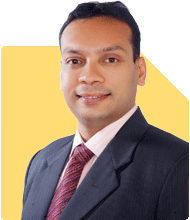Ramalingam Kalirajan |2801 Answers |Ask -Follow
Mutual Funds, Financial Planning Expert - Answered on Apr 16, 2024
He has an MBA in finance from the University of Madras and is a certified financial planner.
He is the director and chief financial planner at Holistic Investment, a Chennai-based firm that offers financial planning and wealth management advice.... more

Sir, I liked the EPF route to build retirement fund. But given 2.5lakh limit that does not seem to be attaractive. Planning to invest half in PPF. Suggest options for rest of the half of the investment. Can I consider guranteed income plans from Maxlife which is giving 6.5 IRR.
Debt Mutual Funds: Opt for short to medium-term debt funds for better returns than fixed deposits with tax efficiency.
Balanced Funds: Invest in balanced funds for equity exposure while maintaining stability through debt allocation.
NPS (National Pension System): NPS offers an additional tax benefit of up to Rs. 50,000 under Section 80CCD(1B) and can be a good long-term investment option.
Corporate Deposits: Consider highly-rated corporate deposits for higher returns than traditional FDs with some risk.
Absolutely, EPF and PPF are great options for retirement planning. For the remaining half of your investment, considering a guaranteed income plan with 6.5% IRR from Maxlife can be a good choice for stable returns. Additionally, you can consider:
Debt Mutual Funds: Opt for short to medium-term debt funds for better returns than fixed deposits with tax efficiency.
Balanced Funds: Invest in balanced funds for equity exposure while maintaining stability through debt allocation.
NPS (National Pension System): NPS offers an additional tax benefit of up to Rs. 50,000 under Section 80CCD(1B) and can be a good long-term investment option.
Corporate Deposits: Consider highly-rated corporate deposits for higher returns than traditional FDs with some risk.
Direct Equity: If you have the expertise and risk appetite, direct equity investment can provide higher returns. However, it requires regular monitoring.
Remember to maintain a diversified portfolio and consult a financial advisor for personalized advice tailored to your risk profile and financial goals.
You may like to see similar questions and answers below
Ramalingam Kalirajan |2801 Answers |Ask -Follow
Mutual Funds, Financial Planning Expert - Answered on May 15, 2024
Ramalingam Kalirajan |2801 Answers |Ask -Follow
Mutual Funds, Financial Planning Expert - Answered on Apr 18, 2024
Ramalingam Kalirajan |2801 Answers |Ask -Follow
Mutual Funds, Financial Planning Expert - Answered on May 14, 2024
Ramalingam Kalirajan |2801 Answers |Ask -Follow
Mutual Funds, Financial Planning Expert - Answered on May 21, 2024
Krishna Kumar |289 Answers |Ask -Follow
Workplace Expert - Answered on May 21, 2024
Krishna Kumar |289 Answers |Ask -Follow
Workplace Expert - Answered on May 21, 2024
Patrick Dsouza |279 Answers |Ask -Follow
CAT, XAT, CMAT, CET Expert - Answered on May 21, 2024
Patrick Dsouza |279 Answers |Ask -Follow
CAT, XAT, CMAT, CET Expert - Answered on May 21, 2024
Ramalingam Kalirajan |2801 Answers |Ask -Follow
Mutual Funds, Financial Planning Expert - Answered on May 21, 2024
Moneywize |108 Answers |Ask -Follow
Financial Planner - Answered on May 21, 2024
Ramalingam Kalirajan |2801 Answers |Ask -Follow
Mutual Funds, Financial Planning Expert - Answered on May 21, 2024
Ramalingam Kalirajan |2801 Answers |Ask -Follow
Mutual Funds, Financial Planning Expert - Answered on May 21, 2024
Ramalingam Kalirajan |2801 Answers |Ask -Follow
Mutual Funds, Financial Planning Expert - Answered on May 21, 2024






















